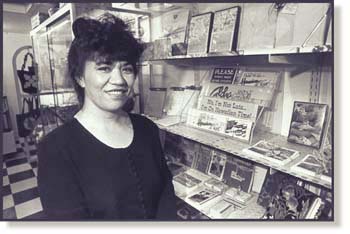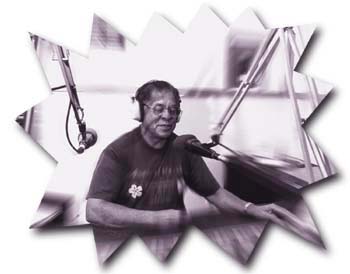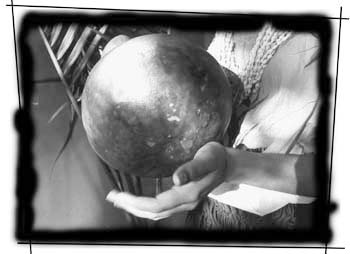Isles Be Seeing You
Lai Lady
Lai: Marlene Thomas owns Capitola's Island Connection and books
Hawaiian performers in the Bay Area as Island Connection Production.
The Central Coast is a hot lava bed of Hawaiian life and
culture
By Randy Fishel
DJ "BRUDDAH" NELSON SAYS IN perfect pidgin,
"Aloha no kakou, this is radio station KHDC, bringing you na mele
o Hawai'i, the good-doing, good-listening music of Hawai'i." But Nelson
isn't broadcasting from the islands. On this particular edge of the Pacific
Rim, the redwoods outnumber palms by a long shot. The temperature is in the
60s, and the ocean averages 59 degrees. This is Northern California, and, for
the tens of thousands of Hawaiian-born and Hawaiian-at-heart that live here,
a few hours of special programming once a week on two public radio stations
and numerous concerts by Island performers help construct a displaced
Hawaiian identity.
According to Kanaka Pono, a Greater Bay Area group
studying Hawai'i-to-mainland migration, current census figures don't
accurately reflect the growing numbers of former Hawaiian residents living on
the Central Coast. Hawai'i's sagging economy and rampant unemployment is being
blamed as the state moves rapidly toward a post-agricultural era. Gone is the
sugar industry from the Big Island's Hamakua coast. There aren't many
pineapples coming from Lana'i any longer, and there's no more sugar cane grown
in Kahuku on O'ahu's north shore. And long-gone is that sickening-sweet smell
of the Dole Cannery in Honolulu's old Kaka'ako-Ala Moana industrial district
that spelled employment for locals and surfers from the mainland.
But one part of Hawai'i's economy is experiencing a boom not
seen since the 1950s. It is having a ripple effect on tourism and travel,
local business and Hawaiian self-esteem. Hawaiian culture is on the market,
and it's selling like fresh manapua on Saturday morning.
Many visitors from Hawai'i, resident expatriates and those
who are simply "Hawaiian at heart" all agree that here on the Central Coast,
it is possible--at times--to forget where you are for a moment and imagine
you are back in the Islands. The centerpiece of this "Hawai'i East" is the
small honolulu, or sheltered bay, of Santa Cruz. Actually nestled near
the northern tip of the larger Monterey Bay, we are nearly a sister city to
O'ahu's Honolulu and have a direct connection with the Islands. Scores of area
residents have Hawaiian friends and family who come regularly to visit and
communicate via mail, phone and the Internet. The climate here, as in Hawai'i,
promotes a beach-oriented lifestyle, with a major focus on surfing and
related watersports, plus a growing number of Hawaiian-style canoe clubs.
But it is the availability of a new "commodity," Hawaiian
culture, that is bringing the mainland Hawaiian community closer together.
Like
Bruddah: KHDC DJ Gordon Brickwood transmits the soothing sounds of
Hawaiian music to Central Coast listeners.
Sounds of Aloha
THE SUREST LINK to ka pono kahiko, the
old traditions, is the music. Music is probably the most mobile and versatile
of all cultural forms, and a renewed interest in Hawaiian music has had much
impact on mainland Hawaiians. Not since the days of Alfred Apaka and Gabby
Pahinui has the demand for Hawaiian music been so great. No matter how far
away from the Islands you are, every time you hear it, you can't help but
henoheno na mana'o o Hawai'i, cherish the thought and idea of the
Hawaiian Islands.
In the Spring of 1991, some dedicated former Hawaiian
"locals" approached Salinas Spanish/English public radio station KHDC-90.9
FM, with a proposal for a Hawaiian music slot. Station officials agreed, and
so "Auntie Nora" Galiza and, later, "Bruddah Nelson" Afoa learned to operate
the equipment. Bearing their own records, they started out with a trial run,
a single hour of air time on a Sunday. As soon as the soothing sounds of
slack-key guitar, lap-steel and beautiful falsetto vocal stylings of
traditional Hawaiian mele hit the air waves, a permanent Central Coast
contact with the islands was established.
Five years later, the Music of Hawai'i program spans a
full nine hours on Sunday. With the exception of station IDs, public service
announcements and a few DJs that "like talk story too much," the volunteer
staff brings listeners uninterrupted music all day long, strictly
kokua from the pu'uwai, help from the heart. There's no
kala, no money here, bruddah.
"The music links people to Hawai'i," says Galiza, "people who
have been there or people who dream about going there."
Gourd and
Light Foot: Hawaiian hula dancers play this hollow gourd called an
Ipu as they make their world-recognized movements.
The Aloha Spirit
Scotts Valley fireman John Stone, 32, agrees.
"Hawaiian music is the only other thing besides surfing that makes me forget
about my problems," he says. Stone and his wife, nurse Sue Stone, 30, are
both avid surfers. When they're not working, surfing or taking care of a
garden full of tropical plants at their Opal Cliffs beach house, they are
lost in the Islands. They average three trips to Hawai'i per year. For the
Stones, it is the Hawaiian music that keeps the aloha spirit in their
hearts.
John Stone went to live in the Islands right after high
school, but says he didn't fully realize the cultural impact it had on him
until he returned to the mainland. "When I came back, I started to put it all
together," he says. "The music tied in with the culture and the people and
everything. Next time, I want to be born Hawaiian."
Hawaiian music has been catching on elsewhere. This year,
Cupertino public station KKUP-91.5 FM added a Hawaiian show to its lineup.
The Pau Hana show airs at 7am every Friday, providing a musical charge
that gets listeners ready--Hawaiian-style--for the weekend. Both KKUP and
KHDC offer Hawaiian events calendars announcing lu'aus, concerts, canoe
races, hula competitions and Island school reunions. There also is a
monthly calendar mailed out by Kapalakiko Productions, which the stations use
as an information source. Kapalakiko, in turn, supports both stations and
promotes Hawaiian cultural events. KHDC has also started a Hawaiian Islands
news show based on information gleaned from the Internet.
As it grows, the mainland Hawaiian community funnels its
energy and resources inward. Money from the Hawaiian events support local
businesses, which, in turn, support local Hawaiian programming. With the
increased interest in Hawaiian culture, local Island artists now can tour on
the mainland and have it help their careers back home. The Na Hoku
Hanohano awards--literally meaning "to exalt the star"--honor Hawaiian
performers and entertainers and have risen to a stature worthy of the
Grammies, Bammies, Country Music Awards and other music ceremonies. It
appears the aloha spirit is not only alive, it's profitable. This page
was designed and created by the Boulevards team.

Robert Scheer
Robert Scheer
Robert Scheer
From the Dec. 26, 1996 to Jan. 1, 1997 issue of Metro Santa Cruz
Copyright © 1996 Metro Publishing, Inc.
![[MetroActive
Features]](/features/gifs/feat468.gif)